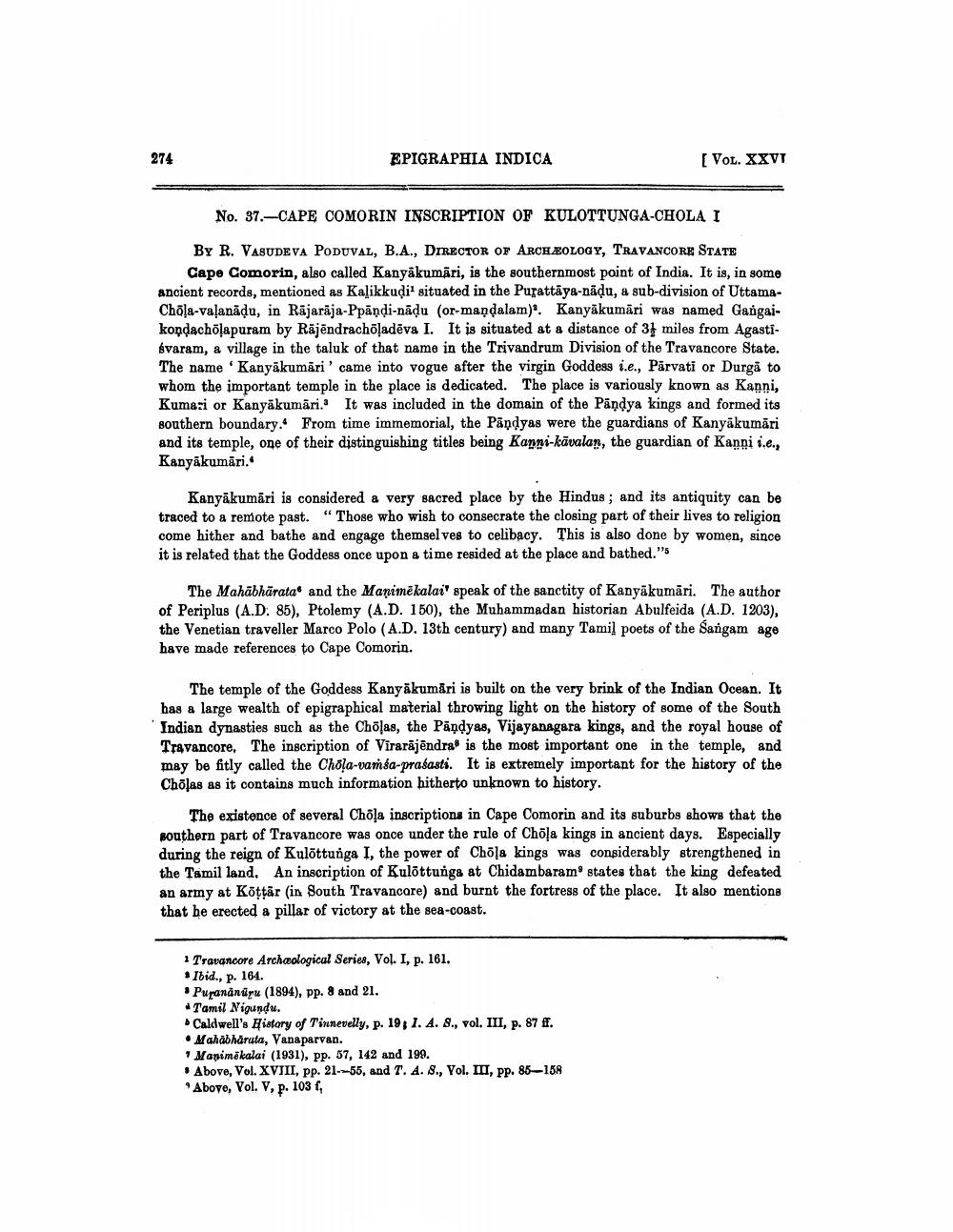________________
274
EPIGRAPHIA INDICA
No. 37.-CAPE COMORIN INSCRIPTION OF KULOTTUNGA-CHOLA I
By R. VASUDEVA PODUVAL, B.A., DIRECTOR OF ARCHEOLOGY, TRAVANCORE STATE Cape Comorin, also called Kanyakumari, is the southernmost point of India. It is, in some ancient records, mentioned as Kalikkuḍi1 situated in the Purattaya-nadu, a sub-division of UttamaChōla-valanādu, in Rājarāja-Ppāṇḍi-nāḍu (or-mandalam). Kanyakumari was named Gangaikondachōlapuram by Rajendrachōladēva I. It is situated at a distance of 3 miles from Agastiévaram, a village in the taluk of that name in the Trivandrum Division of the Travancore State. The name 'Kanyakumari' came into vogue after the virgin Goddess i.e., Parvati or Durga to whom the important temple in the place is dedicated. The place is variously known as Kanni, Kumari or Kanyakumari. It was included in the domain of the Pandya kings and formed its southern boundary. From time immemorial, the Pandyas were the guardians of Kanyakumari and its temple, one of their distinguishing titles being Kanni-kavalan, the guardian of Kanni i.e., Kanyakumari.
[VOL. XXVI
Kanyakumari is considered a very sacred place by the Hindus; and its antiquity can be traced to a remote past. "Those who wish to consecrate the closing part of their lives to religion come hither and bathe and engage themselves to celibacy. This is also done by women, since it is related that the Goddess once upon a time resided at the place and bathed."s
The Mahabharata and the Manimekalai speak of the sanctity of Kanyakumari. The author of Periplus (A.D. 85), Ptolemy (A.D. 150), the Muhammadan historian Abulfeida (A.D. 1203), the Venetian traveller Marco Polo (A.D. 13th century) and many Tamil poets of the Sangam age have made references to Cape Comorin.
The temple of the Goddess Kanyakumari is built on the very brink of the Indian Ocean. It has a large wealth of epigraphical material throwing light on the history of some of the South Indian dynasties such as the Chōlas, the Pandyas, Vijayanagara kings, and the royal house of Travancore. The inscription of Virarajendra is the most important one in the temple, and may be fitly called the Chola-vamsa-prasasti. It is extremely important for the history of the Chōlas as it contains much information hitherto unknown to history.
The existence of several Chōla inscriptions in Cape Comorin and its suburbs shows that the southern part of Travancore was once under the rule of Chōla kings in ancient days. Especially during the reign of Kulottunga I, the power of Chōla kings was considerably strengthened in the Tamil land. An inscription of Kulottunga at Chidambaram states that the king defeated an army at Kōṭṭar (in South Travancore) and burnt the fortress of the place. It also mentions that he erected a pillar of victory at the sea-coast.
1 Travancore Archaeological Series, Vol. I, p. 161.
Ibid., p. 164.
Purananuru (1894), pp. 8 and 21.
Tamil Nigundu.
Caldwell's History of Tinnevelly, p. 19; 1. A. S., vol. III, p. 87 ff.
• Mahabharata, Vanaparvan.
"Manimekalai (1931), pp. 57, 142 and 199.
Above, Vol. XVIII, pp. 21--55, and T. 4. S., Vol. III, pp. 85-158 Above, Vol. V, p. 103 f




